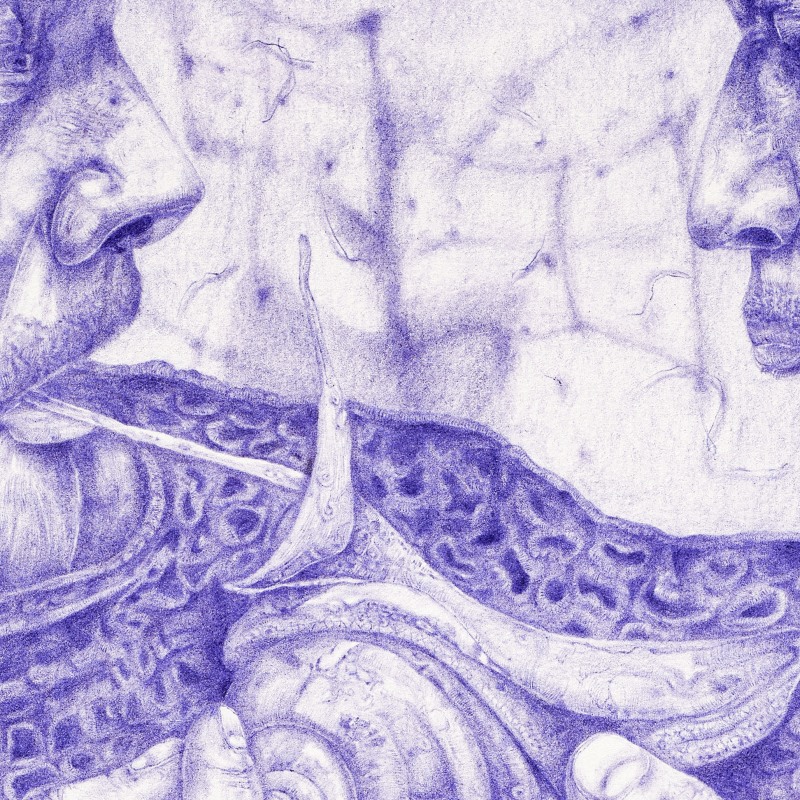Helen Marten exhibits a distinct series of new wall-based works at Sadie Coles HQ Bury Street gallery this October. Each work is a layered sequence of drawing within painting and harnesses a dazzling multitude of mark making. Presented as a holistic architecture of six objects, the exhibition immerses the viewer in an ecliptic environment and is presented in tandem with the artist’s new monographic publication of collected works on paper of the same title (published by Verlag der Buchhandlung Walther und Franz König, with texts by Felix Bernstein, Eve Esfandiari-Denney, Claire Gilman and Elfriede Jelinek).
Treatise of a Coat has multiple physical and linguistic folds. The title is a forcing of the homonymic similarities of “coat”: the literal jacket that is unfurled to expose the naked and unruly shame of human forms; the fur or hair of an animal; the verb-function of to coat, with its intentional building up of visual desire – the lacquering, covering, spreading, enclosing, flooding, directing or husking function that line and colour expediate when creating an image.
To “coat” is to deploy debris, to think of skin or rind or shell; it is the structure or lining of an organ; the layer of a plant bulb; a protective laying down or window of varnish. Perhaps it is adjacent, too, to the concept of difference-and-repetition, an obsessive or simulated application transforming narrative meaning, turn after turn.
The title is also an oblique poke at Honoré de Balzac, at the vast comedic bluntness of his personally unheeded Treatise on Modern Stimulants. It embraces the desire for essayistic but paradoxical or abstract world building. This “treatise” is no such thing, neither formal, nor systematic with its subjects. Instead, it shrugs towards the most delectable etymology – treat: from Middle English, to negotiate and discuss a subject; from Old French traitier, to deal with, or to set forth in speech or writing; from Latin tractare, to handle or drag about; frequentative of trahere, to draw or to pull.
The images deployed in the intense drawings at the centre of each work are those of animals and humans. Both are pivots around which the world spins, conjoined motifs of care and ruination: shelter and movement, supply and modification, each a grammatical cluster around the other. The animal is a classic cipher: parent, lover, child, phantom; they embody our fascinations and our dreams, soft shells upon which to project. The animal is mutually cartoonish mascot and Capital dependency. In a broad contemporary world, it is simultaneously care and labour. When that animal becomes deliberately bestial, it is a portent of something explicitly unbalanced or withheld. It is spirit and talismanic mania. Animals are ultimately surrogate choruses, carriers of language’s continual inexhaustibility.
A box that frames a compulsively detailed drawing is itself another kind of perforated shell, an invitation towards focus and probing. The box proposes control of the hypothetical acceleration of both abstraction and the animal, a containment, and therefore possibility for ruination and release. The frames that hold these drawings are scratched into and drawn upon, cast aluminium greys with the texture of sand; they are a continuation of both geometric and metaphorical planes of caress. Even a drawing inserted within a painting is a deliberate kind of nesting, a gestation of distilled intensity, or a vibrating kernel at the very heart. Perhaps the analogy is simple: we open ourselves to new concepts, then close-down in shame; we dream and shelter and hope for invention.
The constituent materiality of these works holds mutual invitation and absorbency, their shiny and matte faces both a slippage and a friction. A tactic of calculated metamorphosis merges with the intuitive pleasures of painting to generate experiential traffic: the sweaty density of shapes and faces too tightly pushed together; colours spliced awkwardly onto others; definitive wedges of genuine flatness that project outward but not in. There are more eyes, more holes, a cacophony of glyphs and drips and branches. There are fluctuations of mode and mood, grades of temperature and touch, a taxonomy of mutual solidity and dissolve: ghost, rock, hair, twin, flower, snail, wax, bone, tile, skin – all entities to collapse or rip straight into.
Born in Macclesfield, UK in 1985, Helen Marten is an artist and writer who works across sculpture, painting, drawing, video and writing. She studied at Central Saint Martins, University of the Arts, London, and the Ruskin School of Fine Art, University of Oxford, in 2008. She lives and works in London. Recent solo exhibitions include Evidence of Theatre, Greene Naftali, New York (2023); Third Moment Profile | The Almost Horse, Sadie Coles HQ, London (2022); Sparrows On the Stone, Sadie Coles HQ, London (2021); and Therefore, An Ogre, Greene Naftali, New York (2021). Marten received the Lafayette Prize in 2011, the LUMA Award in 2012 and The Turner Prize and Hepworth Prize for Sculpture, both 2016. In September 2021, LUMA Arles unveiled Day Light Songs (biting the air), a significant new permanent commission. Her work is in the collections of The Museum of Modern Art, New York; Moderna Museet, Stockholm; Tate, London; Hessel Museum of Art, Annandale-on-Hudson, New York; Hirshhorn Museum and Sculpture Garden, Washington, DC, and the Solomon R. Guggenheim Museum, New York, among many others. In autumn 2020, her first novel The Boiled in Between was published by Prototype to wide acclaim. She is currently at work on her second novel, A Polite History of Vandalism, and a book of unruly essays on containers, Broken Villas. Her selected critical writings for Sternberg/Institut für Kunstkritik, Mud Physics, publishes in Spring 2026. For the Art Basel Paris 2025 public art programme, Miu Miu will debut a major new performance-based commission by Marten titled 30 Blizzards. at Palais d’Iéna from 22-26 October.
